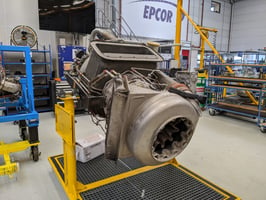This is a video of an interactive visualisation that was used by EPCOR (part of KLM) at the Dubai...
Interactive Tugboat Bridge for Trade Shows
The goal of this project was to find a new and innovative way to showcase the bridge of a tugboat. The resulting VR application has been used during trade shows and events. It is a high-quality and portable solution that allowed Alphatron Marine to better communicate the value of their products.
Less transport and lower costs
Shipping a physical bridge installation to a trade show poses a significant logistical challenge. The installation needs to be checked and updated, deconstructed, packaged, shipped, stored, rebuilt and tested.
- The physical tugbridge installation requires around 5 airfreight containers. The VR setup requires one hard plastic case, which can be shipped or taken as regular hold luggage on a commercial flight.
- The setup time for a physical installation is 2-3 days and requires specialised personnel. The VR setup is up and running in around an hour. And of course, a fool-proof set-up guide is provided.
- The hardware on the physical installation needs to be adapted to be suitable for demo purposes (e.g. for it to work without it being on a real ship). In VR, you can easily show any feature of any product.
- The physical installation depreceates in value because of wear and tear. In VR, you’ve always got a fresh version of your products.
Next-level graphics
The current generation of VR headsets are powerful enough to display high-quality models and materials. Using accurate textures, lighting and reflections, the VR experience comes to life. This increases immersion and more accurately showcases the quality of the products. Usually this quality was only possible when connecting the VR headset to a computer with a powerful graphics card. In this project, all the rendering is done on de headset itself - no external computer needed.
No learning curve
Especially for first-time VR users, controllers can be a hassle. It’s difficult to find the right buttons and you cannot see your hands when wearing the headset. The newer VR headsets use cameras to accurately track your hands. This means you can just reach out and interact with the virtual environment. Just like you would in the real world.
Draw more attention to your stand
Show the virtual world on a big screen to grab the attention of trade show visitors. The person in VR is visible as an avatar on this screen so everyone can see what’s going on, even if they’re not wearing a VR headset.
Join your customer in VR
Continue the conversation in VR! If both you and the client put on a VR headset, you’re on the bridge together. As a sales representative, you can guide the client and answer any questions directy. It’s like you’re really there.

A clear development process
The development of a VR application is split into two phase: a design phase and an implementation phase. The goal of the design phase is to crystallize the vision of the project and translate that to a concrete implementation plan. We discuss the type of VR or AR we might use, decide what the user will be able to do in the application, think about how the application is going to be used and make a detailed planning and budget.
In the implementation phase, the artists and developers bring the design to life. Clients are kept in sync every step of the way and are able to give feedback from the early stages of development.
One of the first milestones in the implementation phase is the so-called whitebox, a rough outline of the final application. 3D artists progressively replace the whitebox with high-quality models and at the same time the developers program and integrate the interactions.
Next Steps
Now that the 3D models have been developed and a first application has been delivered, it can be extended in numerous ways:
- Attach the 3D world to a simulation back-end so that this experience can be used for training.
- Further expand the application by integrating more bridge setups, like one for superyachts and deep sea vessels.
- Develop this experience into a showroom experience where clients can configure their own bridge.


